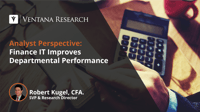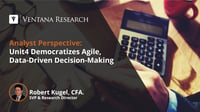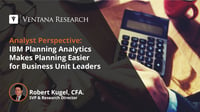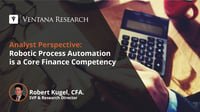Ventana Research recently announced its 2022 Market Agenda for the Office of Finance, continuing the guidance we have offered since 2003 on the practical use of technology for the finance and accounting department. Our insights and best practices aim to enable organizations to operate with agility and resiliency, improving performance and delivering greater value as a strategic partner.
Read More
Topics:
Office of Finance,
Business Intelligence,
Collaboration,
Business Planning,
Financial Performance Management,
ERP and Continuous Accounting,
Revenue,
blockchain,
robotic finance,
Predictive Planning,
lease and tax accounting,
AI & Machine Learning,
profitability management
A year of business uncertainty, lockdowns and operational disruptions forced finance and accounting organizations to adapt and change in many ways that are proving to be permanent. The need to operate virtually resulted in some organizations accelerating their adoption of technology, bringing them closer to achieving a transformation of the finance and accounting function: reshaping the department into an organization that is more forward-looking and strategic. Strategic in the sense of...
Read More
Topics:
Office of Finance,
Business Intelligence,
Data Governance,
Data Preparation,
Business Planning,
Financial Performance Management,
ERP and Continuous Accounting,
blockchain,
robotic finance,
Predictive Planning,
AI & Machine Learning
The annual Ventana Research Digital Innovation Awards showcase advances in the productivity and potential of business applications, as well as technology that contributes significantly to the improved processes and performance of an organization. Our goal is to recognize technology and vendors that have introduced noteworthy digital innovations to advance business and IT.
Read More
Topics:
Customer Experience,
Human Capital Management,
Marketing,
Office of Finance,
Voice of the Customer,
Continuous Planning,
embedded analytics,
Learning Management,
Analytics,
Business Intelligence,
Collaboration,
Data Governance,
Data Preparation,
Information Management,
Internet of Things,
Business Planning,
Contact Center,
Data,
Product Information Management,
Sales Performance Management,
Workforce Management,
Financial Performance Management,
Price and Revenue Management,
Digital Technology,
Digital Marketing,
Digital Commerce,
Operations & Supply Chain,
Enterprise Resource Planning,
ERP and Continuous Accounting,
Revenue,
blockchain,
natural language processing,
data lakes,
Total Compensation Management,
robotic finance,
Predictive Planning,
employee experience,
candidate engagement,
Conversational Computing,
Continuous Payroll,
collaborative computing,
mobile computing,
continuous supply chain,
Subscription Management,
agent management,
extended reality,
intelligent marketing,
sales enablement,
work experience management,
lease and tax accounting,
AI & Machine Learning,
robotic automation
Business process reengineering (BPR) was a consulting fashion in the early 1990s that spurred many companies to purchase their first ERP systems. BPR proposes a fundamental redesign of core business processes to achieve substantial improvements in market and customer responsiveness, productivity, cycle times and quality. Those early ERP systems provided a platform to manage cross-functional business processes with much greater flexibility and efficiency than had been possible in the past,...
Read More
Topics:
Office of Finance,
Business Planning,
Financial Performance Management,
ERP and Continuous Accounting,
robotic finance,
Predictive Planning,
lease and tax accounting
The objectives of zero-based budgeting are well aligned with what I call integrated business planning, a technology-enabled approach to managing the forward-looking activities of a corporation including forecasting, planning and budgeting. IBP enables every business unit to plan their business in a way that makes sense to them but also makes the numbers in those plans available for company-wide planning, budgeting analysis and reporting. IBP combines operational planning and financial budgeting...
Read More
Topics:
Office of Finance,
Business Planning,
Financial Performance Management,
robotic finance,
Predictive Planning
Subscription pricing models are no longer new. Many companies have experience with this pricing model even if there has not been complete adoption across their entire product and service offerings. Companies that use this model, or have spent time looking at the approach, understand the approach of a recurring revenue stream based on a repeating flat fee.
Read More
Topics:
Performance Management,
Sales,
Customer Experience,
Marketing,
Office of Finance,
Financial Performance Management,
Price and Revenue Management,
Digital Commerce,
Predictive Planning,
Subscription Management
Unit4’s Financial Planning and Analysis (formerly Prevero) is a planning and budgeting application designed for the requirements of midsize corporations and the public sector. These organizations are challenged in buying software because they have almost all the requirements of larger enterprises but have a smaller budget and limited technical resources.
Read More
Topics:
Office of Finance,
embedded analytics,
Analytics,
Business Intelligence,
Business Planning,
Financial Performance Management,
Price and Revenue Management,
Digital Technology,
ERP and Continuous Accounting,
Predictive Planning,
collaborative computing,
AI & Machine Learning
IBM Planning Analytics, formerly known as TM1, is a comprehensive planning and analytics application designed to integrate and streamline an organization’s planning processes. It can support multiple planning use cases on a single platform, including financial, headcount, sales and demand planning. The software automates enterprise-wide data collection to make it repeatable and scalable across multiple users and departments. It supports sophisticated driver-based modeling that enables rapid...
Read More
Topics:
Office of Finance,
embedded analytics,
Analytics,
Business Intelligence,
Collaboration,
Business Planning,
ERP and Continuous Accounting,
Predictive Planning,
AI & Machine Learning
Robotic Process Automation (RPA) has emerged as a core digital technology for finance and accounting organizations. It can drive significant gains in productivity and efficiency by automating mechanical, repetitive accounting processes in a continuous, end-to-end fashion. RPA improves efficiency, ensures data integrity and enhances visibility into processes.
Read More
Topics:
Office of Finance,
Business Planning,
Financial Performance Management,
Price and Revenue Management,
ERP and Continuous Accounting,
robotic finance,
Predictive Planning
Ventana Research recently announced its 2021 market agenda for the Office of Finance, continuing the guidance we’ve offered since 2003 on the practical use of technology for the finance and accounting department. Our insights and best practices aim to enable organizations to operate with agility and resiliency, improving performance and delivering greater value as a strategic partner.
Read More
Topics:
Office of Finance,
enterprise profitability management,
Business Intelligence,
Collaboration,
Business Planning,
Financial Performance Management,
ERP and Continuous Accounting,
Revenue,
blockchain,
robotic finance,
Predictive Planning,
lease and tax accounting,
virtual audit,
virtual close,
AI & Machine Learning



















